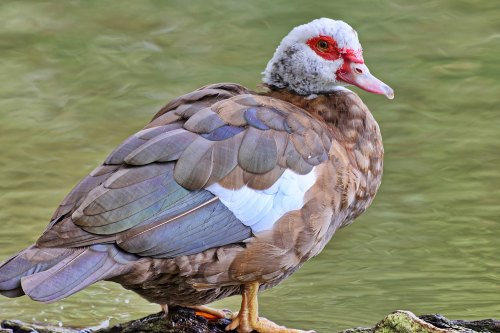The domestic Muscovy duck is one of those rare breeds of duck that didn’t develop in Europe. Instead, it is a breed of duck that is native to the Americas. Mexico, to be specific. This duck didn’t develop domestically either. Instead, it is a wild duck breed that somebody domesticated at some point. The domestic Muscovy duck is now extensively raised throughout the United States.

Let’s take a look at this breed in a bit of depth, shall we?
Domestic Muscovy Duck Facts at a Glance
| Temperament | Quiet and friendly. Only the old drakes can be aggressive. |
| Eggs | 15 eggs per year |
| Use | Meat |
| Weight | Male: 10–15 lb (4.6–6.8 kg) Female: 6.0–7.9 lb (2.7–3.6 kg) |
| Country of origin | South and Central America |
| Foraging | Excellent forager |
| Variety | Black, Blue, Chocolate and White |
Where Did the Domestic Muscovy Duck Come From?
Since this is a duck breed that originates in the wild, there isn’t much to the history of it. Well, at least not in terms of an identifiable history.
The domestic Muscovy duck is descended from the wild Muscovy, a duck that does not migrate. As many other duck breeds it was admitted to the APA in 1874.
There are a couple of theories regarding the origins of its name.
What most people believe in is that the breed is called by a region Muscovy in Russia, that no longer exists (it was the area near Moscow).
Like many European countries, the Russians engaged in trade throughout the Americas.

One company traded in ducks. Specifically, the domestic Muscovy duck.
Therefore, it is assumed that the breed was named after this company which, incidentally, was also called Muscovy.
People have a few other ideas about where the name came from, but this seems to be the prevailing theory at the moment.
This duck had been domesticated long before any Europeans arrived in the Americas.
It was actually seen as a status symbol to own these ducks, and certain elements of Aztec culture involved this duck in some ways.
In rare cases, you may see the domestic Muscovy duck referred to as the Barbary Duck. This is the name given to the bird when it is domesticated.
Although, people still use the term Muscovy even if they have domesticated birds. Barbary Duck is a very, very rare term.
The Unique Look of the Breed
This is one of those rare duck breeds that is found both in a wild variant and a domestic variant. Both of these look fairly similar, albeit with a couple of differences between them.
The Muscovy duck in the wild is a fast bird. It is lightweight. The feathers are always going to be a darker color.
The domesticated Muscovy duck is different, though. Rather than having darker feathers, the feathers can vary wildly. This is due to a lot of inbreeding.

The birds are similar in many ways, though. For example, both of the birds will have crests on their face.
They will also have incredibly large claws, something which you do not find in all that many duck breeds.
Muscovy Duck Colors
The American Poultry Association recognize four color variants of the domestic Muscovy duck:
- Black,
- Blue,
- Chocolate,
- White
The Black Muscovy has black plumage, pink shaded with horn bill and brown eyes.
The Blue Muscovy has blue plumage, it has brown eyes and dark or black horn. It has dusky yellow feet.
The Chocolate Muscovy has milk chocolate plumage, brown eyes and yellow feet.
The White Muscovy duck has pure white plumage and blue eyes. It has orange feet.
The Domestic Muscovy Duck For Meat
Due to the larger size of the domestic Muscovy duck, the main reason this duck seems to be raised nowadays is for food purposes. It makes some good meat.
Actually this is one of the best duck breeds for meat for your backyard.
Muscovy duck size: The males can weigh between 10–15 lb (4.6–6.8 kg), while the hens are a little bit smaller in size, they weigh 6.0–7.9 lb (2.7–3.6 kg).
You should probably bear in mind that this duck, even the domesticated version, probably won’t taste like any duck that you are used to.
This is because the Muscovy duck meat has a more gamey taste.
This is one of the main reasons why it was eaten in the past. If you do not like that gamey taste, then this bird is not for you.
Use for Feathers
In the past, the main reason for the raising of this breed was for feathers. As I said before, this duck played a role in Aztec culture.
The leaders in Aztec culture would often decorate their clothing with these duck feathers.
Nowadays, I can’t imagine that many people are using duck feathers from the domestic ducks. However, the feathers do tend to be soft and of a high quality so they can be used like that if you wish.
The Muscovy Duck Eggs
The domestic Muscovy duck can brood three clutches per year and it lays around 15-eggs.
This isn’t going to be enough for most people, I imagine.
Despite this breed being extensively raised for centuries, nobody has really tried to improve the number of eggs that it lays.
However, I suppose that this isn’t really required. There are a lot of duck breeds out there that can lay eggs, like our two favorites, the Appleyard duck and the Khaki Campbell.
Breeding the Domestic Muscovy Duck
This bird is very difficult to breed. This isn’t just because it only lays a few eggs each year too.
This breed is one of the rare ducks that doesn’t breed through forced breeding i.e. the drake forcing himself onto the female.
Other duck breeds do breed like that.

The way in which the female genitalia is set up actually prevents this from happening. The female duck will have to want to breed with a particular drake or it isn’t happening.
This means that you may have incredible amounts of difficulty getting these ducks to breed.
In addition to this, a lot of domestic Muscovy ducks are sterile. This is due to breeding with various other duck breeds.
If you do not know the lineage of your duck, then it is probably not a good idea to breed it.
Chances are high that it will be sterile.
Raising Muscovy Ducks as Pets
Muscovy duck can fly, so the biggest tip I can give you if you are planning on raising the domestic Muscovy duck is to have the wings clipped.
Not only the wild, but even the domesticated Muscovy duck is a very good flier, and they tend to enjoy migrating.
If you are not clipping their wings, you probably will not be owning these ducks for all that long. Many people have lost entire flocks overnight!
The Muscovy duck nesting habits are quite interesting. You should try to ensure that you have a lot of trees for the duck. This is a bird that seems to enjoy nesting a little bit higher up than your average duck breed.
This is a good looking bird. However, the rarity of the bird, plus the lack of actual use outside of meat, means that it is not really used as a show bird.
There are breeding clubs dotted throughout the United States and Europe, but shows do not seem to be happening that frequently.
Most of these breeding clubs are there to preserve the future of the bird rather than show it off.
This duck is a great forager, this makes them excellent for pest control. In fact, many people raise Muscovy ducks just for this purpose. They are great to control ticks, flies and other insects.
Regarding it’s diet, you are aware that ducks are omnivores right?
This means that the Muscovy duck diet is consisted of meat and plants. For the most part, the duck will eat plants, insects, and small water-dwelling animals, particularly crustaceans.
In fact, a good amount of their food is going to come from the water.
Muscovy Ducks For Sale
If you are lucky enough to live near a local hatchery that’s awesome, If, however, you are among the unfortunates, consider this list of hatcheries with Muscovy ducks for sale I have recently listed as great options.

Pingback: 10+ Hatcheries With Muscovy Ducks For Sale in US - ChickenMag